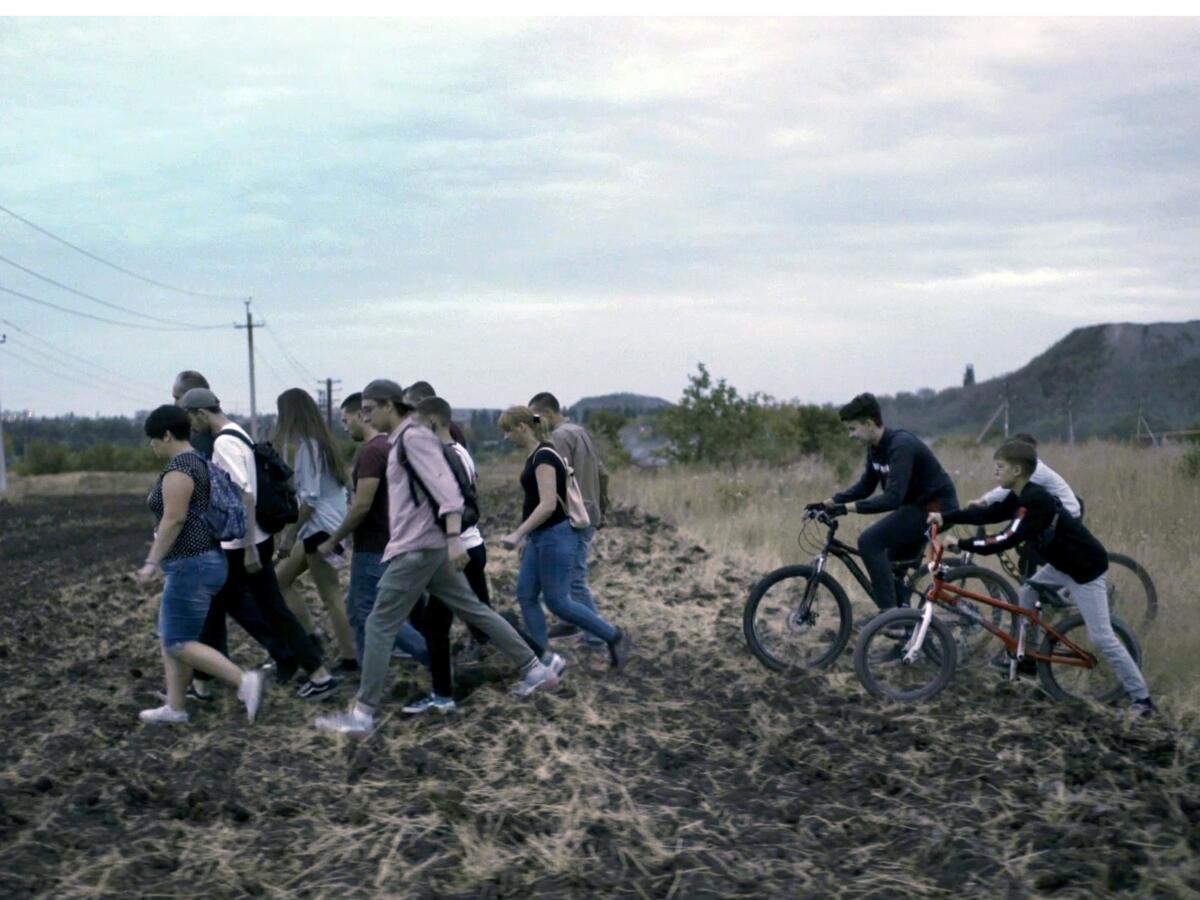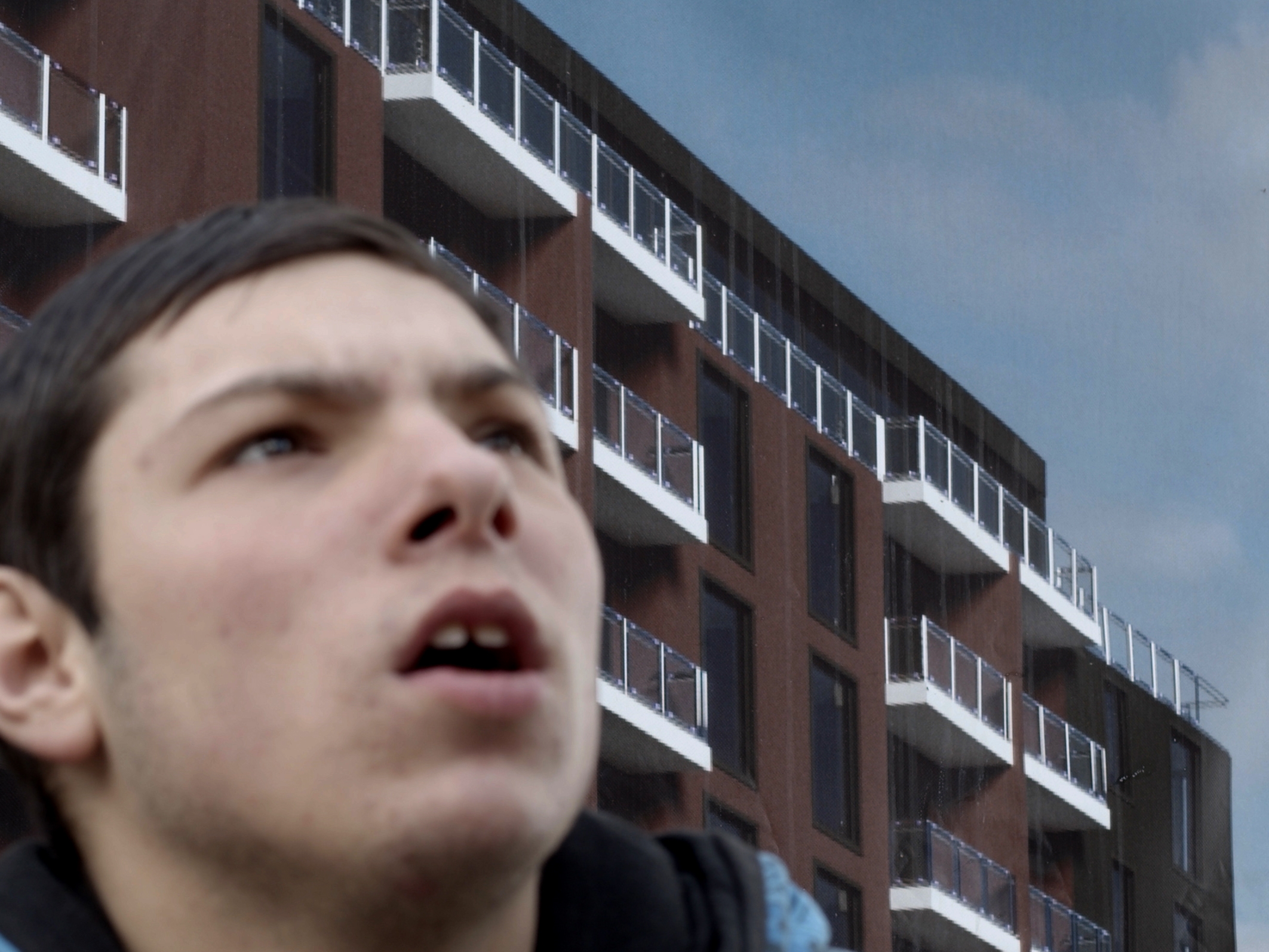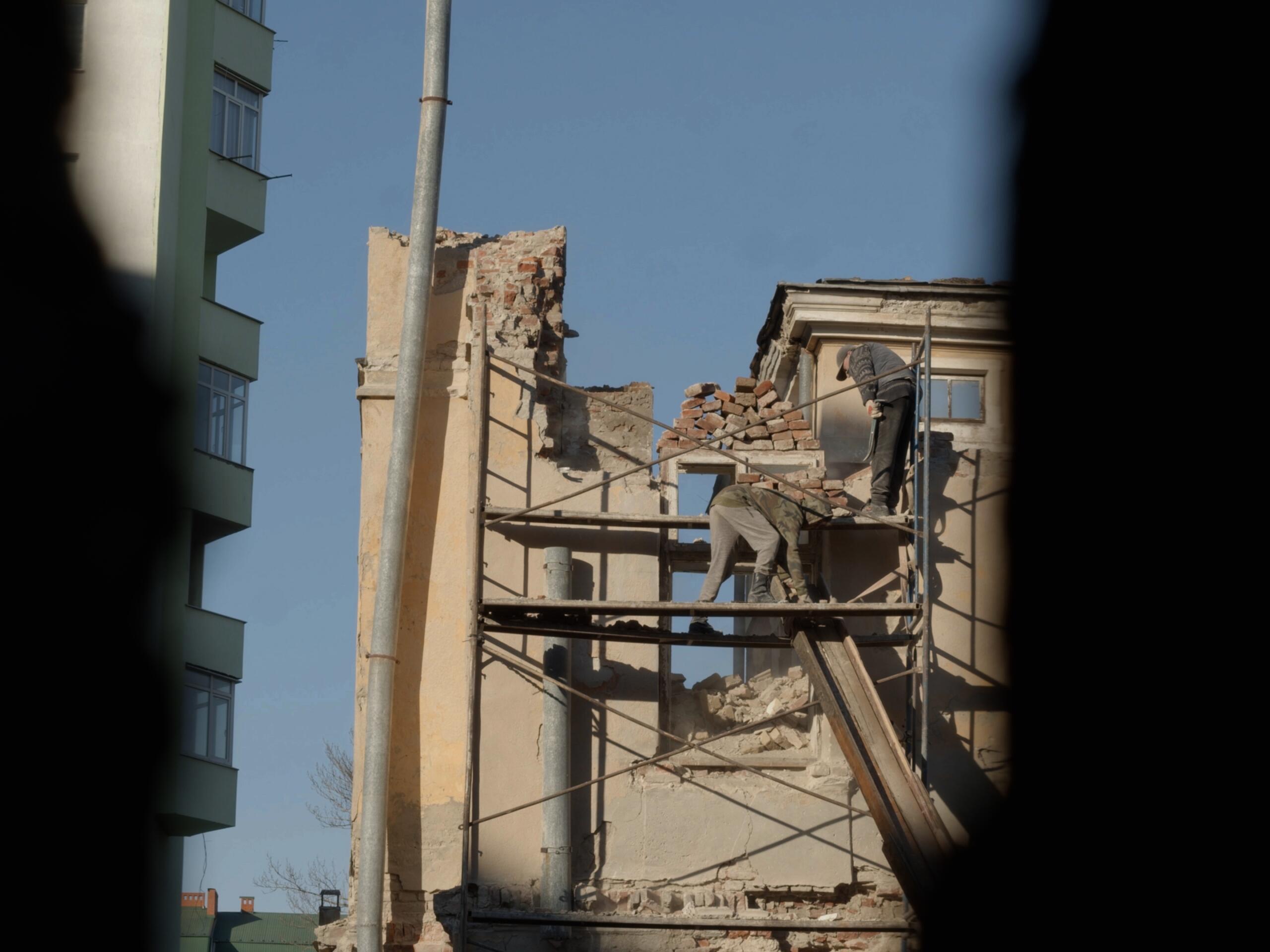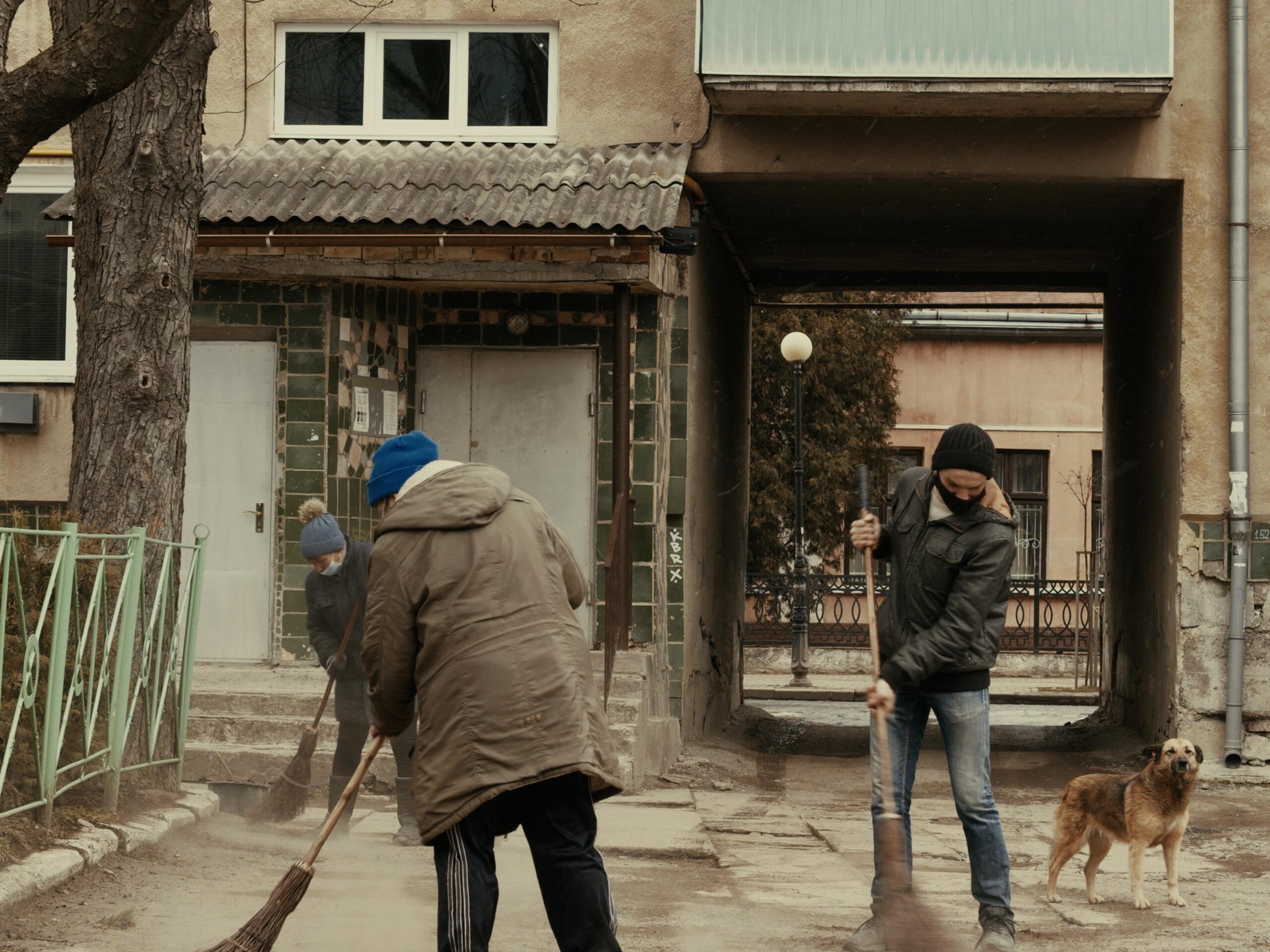
In a “new” common world, should we dive into another utopia of unity? Or should we prepare for a walk among its shards?
The Ukrainian artist duo Yarema Malashchuk and Roman Himey (informally known as Yarema & Himey) balance their practice on the edge of two branches of contemporary culture: video art and film. At first glance they might appear to be filmmakers testing the language of cinematic technique within the space of contemporary art. However, in a decidedly artistic gesture, their new exhibition deconstructs the directorial mono screen using various video works to experiment with spatial narrative-building.
New City of Friends is Malashchuk and Himey’s first solo exhibition, and is on view in May 2021 at Shcherbenko Art Centre in Kyiv, Ukraine. The production of a solo exhibition is part of their prize for winning the biannual Young Ukrainian Artists’ Competition (known locally as MUHi, its Ukrainian language acronym) in 2019[1]. In addition to MUHi, the duo has recently presented their documentaries, mockumentaries, and short films through cultural platforms in Ukraine and abroad, including, notably, the international film festival Docudays UA, a collaboration with Dutch artists Metahaven, and participation in the Pinchuk Art Prize 2020. In this sense, much of their previous work found them inside the creative bounds imposed by various forms of collaboration. Now, in their solo show, they aim to create a broader story of their own, independent of thematic curatorial conceptions like those imposed on past projects.
Roman Himey: Unlike most other artists, we started our practice with contests that often resemble sports competitions, but we have long been waiting for a solo show. We always work with films that need complex production and budgeting, which often leads us to concentrate on the mono screen. Despite this, we have always had ideas for communicating with the viewer through multiple videoworks.
Peter Straub, a film theorist, mentioned that while working with a screen in a gallery, you a priori work with two spaces at the same time. The exhibition space itself provokes the artist to work with its environment, and for those artists who work with video, it is always a double process, because cinema is about another dimension, perspective, time, playwriting.
THE COMMON IN THE NEW CITY OF FRIENDS
The exhibition features several films and video performances shot in two vastly different Ukrainian cities; Myrnohrad, an eastern, post-industrial coal city situated in the Donetsk region, and Kolomyia[2], an old western city with a complex history in the Ivano-Frankivsk region. Despite the geographical polarity of the cities, the artists do not present them as contradicting units. The work focuses instead on the independent political and historical backgrounds of the city’s disparate contexts.
In this way, the project features a long process of studying the local landscape, in addition to being a technical experiment with the artists’ usual medium. Their work highlights the common actions of actors within a particular space, an approach both informed by the past and engaging the general concept of the common[3] in the present. The title of the project comes from I Dreamed in a Dream (1867), by Walt Whitman, a poem also referred to in the duo’s short video essay Dedicated to the Youth of the World (2017). In this project, the American poet’s mid-19th century vision of unity suggests a socialist vision in the contemporary cultural discourse, which in turn becomes a critique of neoliberalism.
I DREAM’D in a dream, I saw a city invincible to the attacks of the whole of the rest of the earth; /
I dream’d that was the new City of Friends; /
Nothing was greater there than the quality of robust love—it led the rest; /
It was seen every hour in the actions of the men of that city, /
And in all their looks and words.
Walt Whitman, 1867

Yarema Malashchuk and Roman Himey, ‘New City of Friends’, still from the movie, 2021, courtesy of the artists
In speaking with Malashchuk and Himey, it becomes clear that part of their interest in urban studies comes from an immersion in the socio-political connection between cities and art. In particular, Pascal Gielen writes about the notion of the common or commonism as tangible and intangible resources that the community manages together in his essay “Performing the Common City”[4].
Gielen, a sociologist of culture, chronologically classifies cities as monumental, situational, creative and common according to the position of art within the existing infrastructure of the city. In this classification system, a city appears to be a common if its space encourages the implementation of free creative expressions referred to as a tactic[5] by Gielen, rather than relying on strict governmental initiatives referred to as strategy[6] in opposition to tactic. A city is a dynamic and flexible structure in which bottom-up initiatives are supported by capital from above, and everyone has the opportunity to capture the shared urban space[7].
In the narrative of Malashchuk and Himey, the concept of the common becomes a device for studying the urban realities of post-industrial Myrnohrad and historically cosmopolitan Kolomyia. They simultaneously construct and deconstruct a common or the New City of Friends with shards of cities stuck between Gielen’s monumental and situational classifications. The artists themselves, as well as the artists of a common city, analyze the structure of the urban spaces in order to transform them through their works. The show’s title itself, New City of Friends, gathers the individual video pieces together, and simultaneously manifests the ambiguity of the concept of the common, as it is applied to points of both universal and definite geographical, historical, and social landscapes.
Yarema Malashchuk: The project is also about trying to understand what the city should be like. You come to an exhibition called New City of Friends, but you find everything except the city of friends there. This is an extension of an image of Don Quixote which has been transformed. Like chivalry, love is not dead, it needs to find new ways of expression. It has to transform and find new strength to be reborn. I’m also talking about rights and freedoms, about community and friendship. Ideas of a common future and unity always sound naive. Roman and I use irony to talk about them too, but we can’t dismiss them either. A New City of Friends is something you use as an instrument for hope.
THE POST-INDUSTRIAL LANDSCAPE OF MYRNOHRAD
With chronology nearly absent, and all elements distinctly yet equally referring back to the central concept, there is no opportunity to state the starting point of the exhibition. For the purposes of this article, however, we begin with the exhibition’s elements dealing with Myrnohrad in Donetsk Oblast. Mining, the main industry of the region, has long been the city’s economic driver. The city developed structurally around Novator, the industry’s main site.. This Soviet approach to urban development has become completely impractical today. And yet, in a post-industrial world characterized by recognition of the environmental threat of extractive industries and the constant collapse of mining networks, this urban formation continues to be a key element of the landscape.
Such transformations, where the present becomes the past, are the focus of the artists’ attention. The video work So They Won’t Say We Don’t Remember, is based on events surrounding a 1977 mining accident that ultimately led to the mine’s closure. Surveyors calculated the exact location of the accident on the outskirts of the city, in order to erect an obelisk in memory of the victims. Almost half a century later, the artists joined together with local people to create a video work exploring the presence of this history[8].
Yarema Malashchuk: Together with the residents of Myrnohrad, we walked from the ruins of the mine to the monument to dead miners. Our route was clearly tied to the underground passages of the Novator mine, but we were moving on the surface. It was a decentralization of the monument, which changed the understanding of the region from monumental industrial to post-industrial. In Donbas we often heard the expression “So they won’t say we don’t remember” not necessarily with reference to memory, but always as an appeal to the center, to something different. In this work, we create a monument in motion, a commemorative march that affirms the region’s memory.
Roman Himey: In general, since the beginning of the pandemic, everyone has stopped in time and space in their own way. After such a pause, you start to look not so much around, but more under your own feet. The history of the Novator district, both hidden and visible, and the knowledge we gained after the walk provoked us to reconsider the soil of our hometown.
KOLOMYIA RESIDENTIAL YARD PAVED WITH JEWISH TOMBSTONES
From one end of the exhibition space to the other, the viewer travels the length of Ukraine, from Myrnohrad to Kolomyia. More specifically, from the miner’s memorial to a residential yard on Franko Street, where a group of hired cleaners are at work. They paint the curbs, refresh the green colour of the fence, sweep the ground, clean the cracks with a knife. A housing association is responsible for this territory. This is not, however, a usual courtyard. Its surface was paved with hebrew-inscribed tombstones (matzevot) in 1967 by Soviet authorities, more than 20 years after the mass extermination of Jews during the Holocaust. Records show that up until 1941, Jews made up as much as 49% of the local population of the city.
In total, there were three Jewish cemeteries in Kolomyia, all of which have been destroyed. The oldest, dating to the 18th century, was located next to the town hall. It contained the remains of the disciples of the Baal Shem Tov, the founder of Hasidism. The second cemetery, which was the source of the controversial paving stones featured in the video, has been turned into a park. The last cemetery dates to the early 20th century. All that remains of it today is a fence still scarred by bullet holes. The area of the cemetery is now used as a football field.
Yarema Malashchuk: The Soviet Union wanted to build a new city, Kolomyia for the proletariat, that was meant to be for the Ukrainians, for “those who it belongs to” as the current citizens say. The gravestones were placed by the Soviet authorities, but today the residents of the yard still don’t want to remove them because they are afraid that the yard will remain unpaved. The city council also denies responsibility and says that all it lies with the resident’s association. The city continues to live in this bureaucratic status quo of privatization.
Kolomyia’s local TV channel NTK has repeatedly broadcast public discussions on the fate of the Jewish cemeteries. A demonstrative example for understanding the situation was the recent row over the Jewish community’s initiative to fence off the burials in one of the park areas. The city council holds that this move violates the new land legislation, while some local residents are worried that by allowing the Jewish community to own the land, they will also occupy other areas[9]. On the other hand, local activists are emphasizing the importance of reaching an agreement, in part because the Jewish community’s history on the land predates that of the current residents who were relocated from rural areas during the Soviet period.
Roman Himey: If Donbas has always suffered from the metropolis’s ironic gaze, Kolomyia suffers from the ironic gaze of the historical drama itself. As in the most prosaic Greek tragedy, the Ukrainians are granted their “Ukrainian” Kolomyia, but only in an unexpected way, through their “liberation” by Soviet troops. This Ukrainization of the city reminds me of a scene from the film adaptation of Goethe’s novel by Sokurov, where Mephistopheles forcibly pulls the knightly armor onto Faust. Then Faust, with a crooked grimace and teary eyes under the weight of chain mail, tries to straighten into a pose of a warrior. The responsibility for forgetting the Jewish population of Kolomyia, becomes a relay, passed by the Nazis to the Soviet authorities, and now it has reached the current residents of the housing projects. The circle of those responsible narrows to a specific community. Each year residents hire cleaners and painters to tidy up the private area before the spring holidays. They clean the slabs in front of Soviet buildings with brooms and knives, not realizing that their choreography is approaching a commemorative ritual. The tombstones from the Jewish cemetery vibrate underfoot, and despite its current circumstances, it still retains its original significance. Decolonized Kolomyia comes out of someone else’s dream in its private castle of hopes for power.

Yarema Malashchuk and Roman Himey, ‘New City of Friends’, still from the movie, 2021, courtesy of the artists
MODERN URBAN PLANNING AND DECONSTRUCTING
The study of the city’s partly hidden history led the artists to focus on the external changes that are happening to objects of the past in their hometown today. Moving through Kolomyia, their attention was drawn to the process of deconstruction of the military barracks that was built during the rule of the Austro-Hungarian Empire, from 1867–1918. Having previously gone unrecognized as an architectural monument, it is simply being dismantled brick by brick by locals over time. Lingering near the demolition site, it becomes clear that bricks are not being thrown away, but rather selected and carefully cleaned, probably for some new construction or interior decoration.
Roman Himey: During the Austro-Hungarian Empire, the Ukrainian peasantry of the border kingdom of Halychyna[10] [also called Galicia, a historical subregion where present-day Kolomyia is located] was deprived of land and exhausted by poverty. In fact, it was the poorest region of the empire, which caused mass labor emigration to Brazil and Canada. But now only a few people mention that. You’re more likely to hear people saying, “Whatever happens, life was best living during the Austrian times.”
Yarema Malashchuk: Near this antibuilding we noticed several children playing with the same bricks and carrying them to the yard of their apartment complex. The children’s actions looked like an act of hope, but at the same time a parody of the men who were dismantling the house. They are breaking the context of modern urban planning, creating a New City of Friends. The name of the exhibition project also arose after our observation of this capitalist building process, chaotic consumption, destruction. In the children’s gesture, this inverted construction seems to appear out of a naive wish that something new and better will emerge after. Eventually, against the background of destruction, the construction is reborn.
In the context of the modern urban planning in Kolomyia, the artists also present another film, the story of which is starting a dialogue with a hypothetical fate of the Austrian remains. In another part of the city is a cafe Kibler founded in the former studio of Oleksandr Kibler, a local court photographer active from the Austro-Hungarian Empire till the Soviet period. Now the cafe’s interior appears to be an apogee of layering altogether the historical landscapes where Kibler’s scanned photos[11] hang on similar brick walls, coexisting with the cheap, colorful, modern furniture.
PERFORMANCE BY FICTIONAL ROUTES AROUND KOLOMYIA
The creation of a common narrative is a remarkable part of the following Kolomyia-based video performance consisting of a tour by a young local resident, Maksym. He walks along the path near the Austrian barracks, drawing possible routes through the city in the dirt with a stick. It is his daily performance; “From Bandera Street I go to the 10th School, from the 10th School I return to Kirov Park, from there I return here and see a well. I go from the well to the bookstore, and from the bookstore…”, and so on.
In the video, a group of locals is accompanying Maksym in his imaginary journey through Kolomyia. There are several women, children, and a man. The performative procession by the residents of Kolomyia becomes part of the bigger procession that previously started in Myrnohrad. Each of these groups of people, by drawing a local geography from deep in the ground or collecting the important routes from above, creates the landscape of these two cities. Each makes visible points in the fabric of the city that are invisible to modern local discussions.
Yarema Malashchuk: Maksym is 15 years old, he is a strange city character who corresponds to the image of a modern city, where there are the endless constructions; the houses are being constantly assembled and dismantled, and the cult of the Austro-Hungarian Empire coexists with the post-Soviet reality. Maksym seemed to us a personified agony of this city. He is a kind of everyman, neither small, nor old, neither poor, nor rich. In the vastness of modern buildings and the past that is always present, he seems to be in a hurry, but actually, he is never going anywhere.

Yarema Malashchuk and Roman Himey, ‘New City of Friends’, still from the movie, 2021, courtesy of the artists
HALF-RUINED DREAM SHIP
Eventually, through a wide range of factors, a range of instruments of the show’s dramaturgy emerge. Through the connections between points in time, sites on the map, intersections of social groups or power regimes, an irony appears, followed by empathy, hope, anxiety, or comprehension. Despite our desire to rebel, our navigation through the exhibition, like our personal path through the landscape of modernity, remains the same for everyone.
In the vortex of myths and historical facts, the New City of Friends seems to be in opposition to the repressive ideologies of the past. But, on the other hand, it creates its own ideology. Here, commonism appears to be not a call to the future, but an analysis of the common that already exist within the socio-historical background of certain cities.
Yarema Malashchuk: New City of Friends is like a half-ruined dream ship. This exhibition includes works that speak of the uncertainty of the future and the chaos of the past. Donbas appears as a territory far from the capitalist agony of building constructions, as well as the agony of the military occupations that befell Halychyna. In Donbas there is a vital energy of the post-apocalyptic New City of Friends. As if we are walking on new untrodden routes in a region of war, industrialization, and environmental catastrophe. We are trampling on the New City of Friends, which makes our hopes for it very difficult.
We also want to create a space which has a feeling that between criticism, there is also enthusiasm, and a playfulness with all the terms, with geography, landscapes. We live inside all of this, and we have compassion for the locals. And there is love for the past and for the memory of cities.
In the end, we find ourselves at a gallery exhibition in Kyiv, a city that arguably has the most multi-form landscape in Ukraine, and is perhaps the most sensitive to the vicissitudes of history and the clashes of socio-cultural narratives. In terms of the exhibition theme, its venue acquires a special significance. Despite the absence of Kyiv in the video surveys of Ukrainian cities, its physical presence contributes to its loud cosmopolitan commonism. We still find ourselves in the New City of Friends, composed of parts of the cities present and absent in the exposition of the project. But is this space a city? Is it common? Is it new?
[1] MUHi is a multifunctional project aimed at consistent and long-term work to support Ukrainian artists at the stage of their formation. Based on the results of the open call, an international team of experts selects 10 finalists of the competition for the group exhibition. The three winners of MUHi are receiving a cash prize and the opportunity to make a personal project in Shcherbenko Art Centre. Source: https://www.shcherbenkoartcentre.com/uk/myxi/muhi-2021/.
[2] Kolomyia is also a hometown of the artists.
[3] Used with reference to Pascal Gielen in Performing the Common City: On the Crossroads of Art, Politics and Public Life (2015) / translated from English to Ukrainian by Y. Strikha, Y. Didokha, Т. Rodionova, V. Yadukha. – Kharkiv : IST Publishing (2019).
[4] ibid.
[5] While working on classification of the cities, Gielen is mentioning two oppositions: place vs space and strategy vs tactic. According to De Carteu, place is a well-defined and strictly-delineated domain whereas space is characterised by movement and temporality. Then, Michel de Carteau is referring to strategy as an instrument of those in power, whereas tactic is a short-term action developed by a city user to deal with a made plan. Based on this opposition, Gielen characterizes the monumental city as the one operated by place and strategy, the situational city operated by place and tactic, the creative city operated by space and strategy, and the common city operated by space and tactic.
[6] ibid.
[7] See note 2.
[8] The work was created as part of the Landscape as a Monument residence for artists, curators, researchers and activists organised by the Platform for Cultural Initiatives IZOLYATSIA with support of Ukrainian Cultural Foundation in the summer of 2020. Curators: Oleksandra Pogrebnyak and Dmytro Chepurnyi. The participants were invited to work with both cultural, environmental and industrial landscapes and human/nature dichotomy through contemporary art, ecology, or politics.
[9] From the news report of the NTK TV channel on June 25, 2016. Video is accessible via the link: https://www.youtube.com/watch?v=3indk87jcL0.
[10] Galicia or Halychyna (as in Ukrainian) is a region that occupied the territory of western part of modern Ukraine and eastern-southern part of modern Poland. During the Austrian-Hungarian Empire it formed the Kingdom of Galicia and Lodomeria. Referred to the Lviv, Ternopil, and Ivano-Frankivsk oblasts in Ukraine now.
[11] While there is a huge collection of Kibler’s photos in the attic of the cafe.
Imprint
| Artist | Yarema Malashchuk and Roman Himey |
| Exhibition | New City of Friends |
| Place / venue | Shcherbenko Art Centre, Kyiv, Ukraine |
| Dates | 7 May – 6 June 2021 |
| Website | www.shcherbenkoartcentre.com |
| Index | Milena Khomchenko Roman Himey Shcherbenko Art Centre Yarema Malashchuk |

